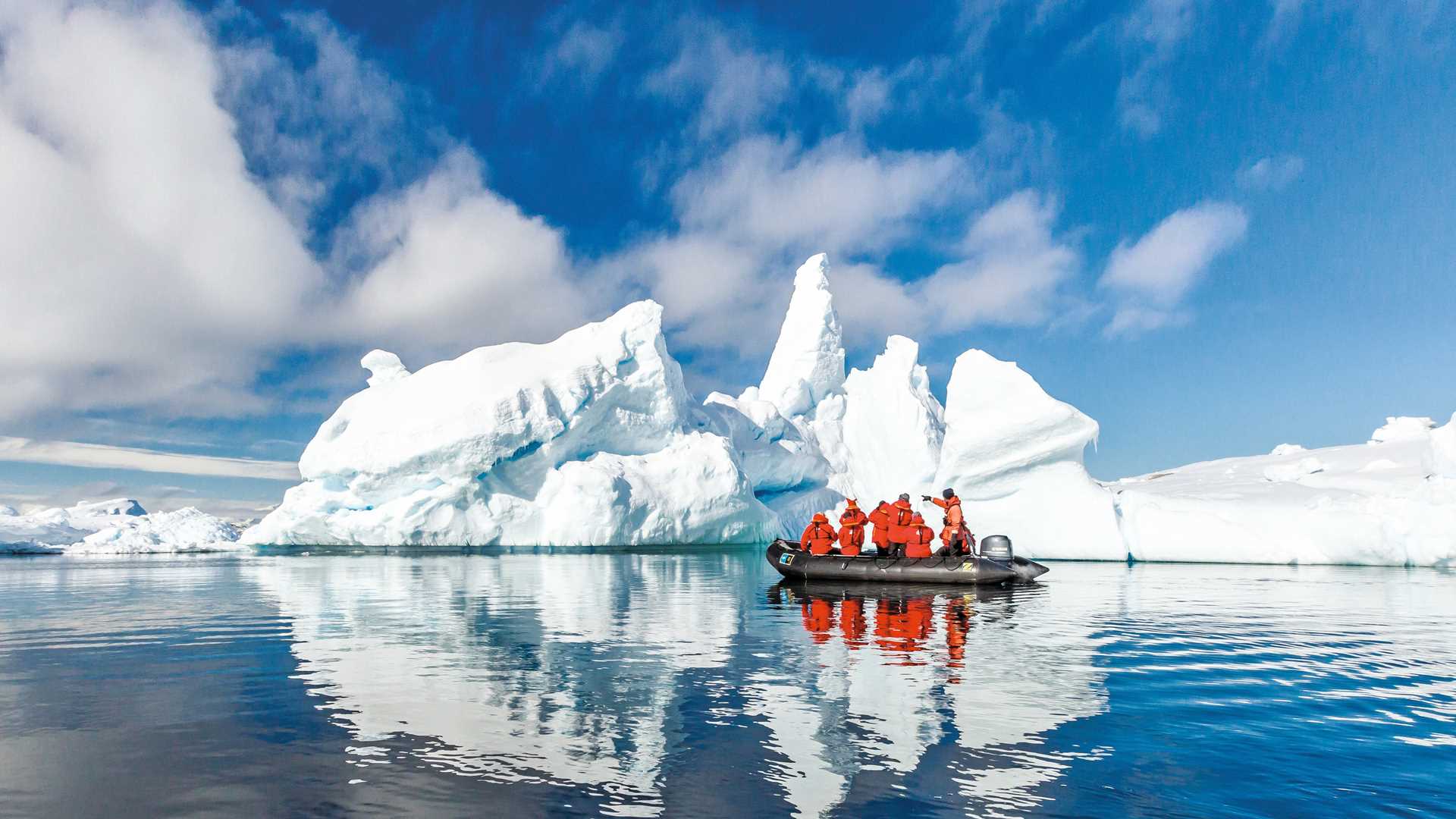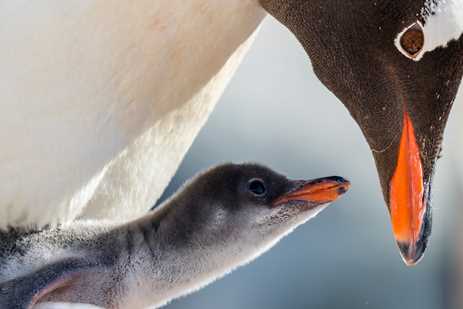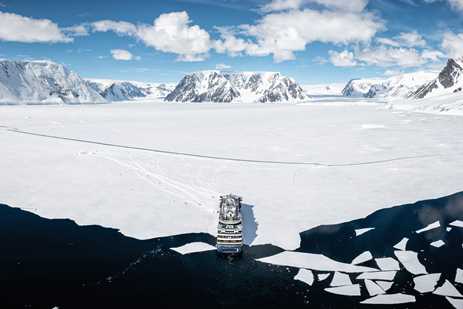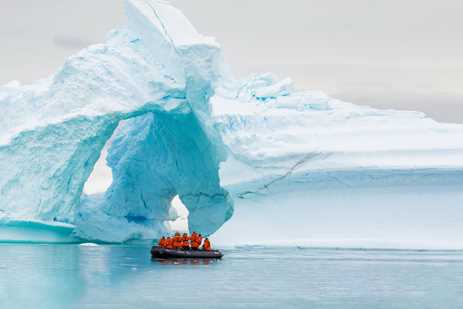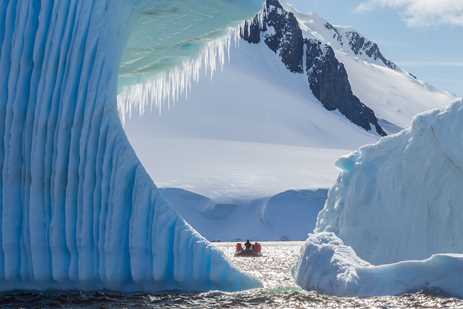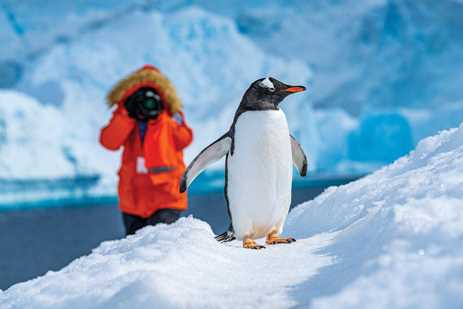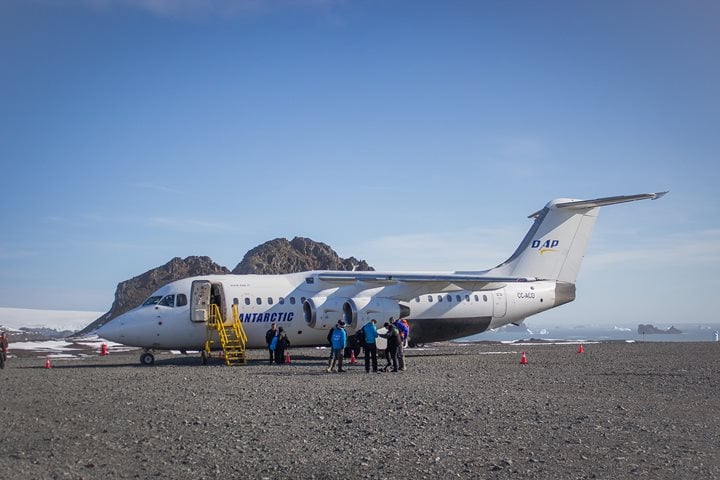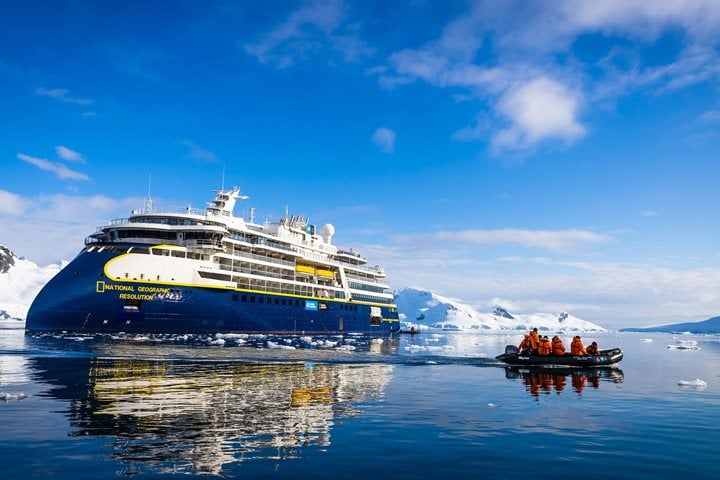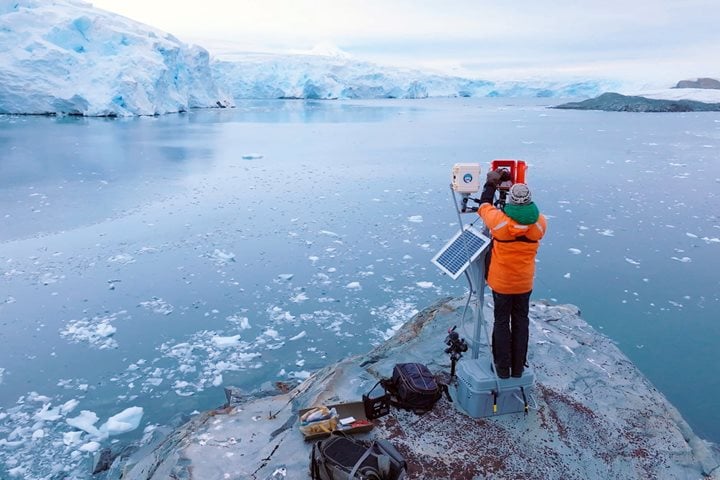Call +1.800.397.3348 or contact your travel advisor
Exploring Antarctica is a once-in-a-lifetime experience every adventurous traveler should consider. But heading to the bottom of the globe to this legendary kingdom of ice and snow requires quite a bit more research and planning than your run-of-the-mill beach vacation.
If a trip to Antarctica is on your travel list, you likely have a lot of questions. For starters: Will you need a passport or visa? Yes, you will need a passport to visit Antarctica since you’ll be traveling through several countries that require one in order to reach Antarctica.
You may also wonder if travel insurance is required and what currency you’ll need to bring. All good questions. Lindblad Expeditions has been bringing citizen explorers to Antarctica on expedition cruises since 1966, and has a wealth of information that will help answer all of your queries.
Do You Need Permission to Go to Antarctica?
Something a lot of people ask is, are you allowed to go to Antarctica as a tourist? In a word, yes.
The reality is that anyone can go to Antarctica. However, under provisions of the Antarctic Treaty, which was created in 1959 by 12 founding nations, permits are required to regulate tourism and help protect Antarctica’s fragile environment.
Most guests won't need to get bogged down in those details since operators, such as National Geographic-Lindblad Expeditions, who are members of the International Association of Antarctica Tour Operators (IAATO), secure permits for their expedition cruises and by extension, all of their guests.
Guests, however, will need a valid passport and, in certain instances, a visa for transit countries—see below for additional details. Keep in mind, too, that travelers visiting Antarctica independently (without a tour provider) need to obtain permits on their own.
For a deep dive on what it is like to visit the White Continent, read this helpful guide on how to travel to Antarctica as well as the best ways to explore there, including hiking in Antarctica, kayaking in Antarctica and Antarctic photography.
What Documents Do I Need to Go to Antarctica?
You don't want to travel all the way to the bottom of the globe, only to forget a crucial document. Here is a look at everything you will need.
Do I Need a Passport for Antarctica?
Passports are not required in Antarctica per se. However, passports are needed in transit countries, or departure points to the White Continent like Chile, Argentina, Australia, or New Zealand.
Passport Validity for Antarctica Travel
As a rule of thumb, be sure your passport has sufficient blank pages for stamps and is valid for at least six months beyond your travel period.
Is There Passport Control in Antarctica?
There is no passport control and there aren’t any foreign embassies either, so lost passports and related issues will need to be addressed in one of the transit countries.
To avoid hassles (and keep your focus on Antarctica’s wildlife!), remember to keep your passport packed safely throughout your journey. For more on what to bring, see this complete Antarctica packing checklist.
Antarctica Visa Requirements
Visas are not required in Antarctica, and may or may not be required in a transit country depending on its specific regulations and a traveler’s nation of origin.
Australia, for instance, requires visitor visas. United States, Canadian, and British passport holders do not need visas for short stays in Chile or Argentina. Be sure to double check the relevant government websites for any countries you will be passing through on route to Antarctica.
Antarctica Entrance Fees
Travelers indirectly pay entrance fees to visit Antarctica as part of their trip costs. This is because IAATO’s funding comes primarily from fees charged to member travel providers, which help fund conservation efforts.
Fees depend on the number of passengers travel providers bring to the White Continent, and how long they travel in coastal waters south of 60 degrees south or South Georgia. Fees for the 2022-23 season were USD $3.50 per traveler, per day.
For an in-depth look at how much you can expect to pay to visit the White Continent, see this complete guide to Antarctica cruise costs.
Other Requirements for Visiting Antarctica
Safe and responsible tourism, for travelers and Antarctica’s environment, are two additional requirements for visiting.
Info on local laws, such as not bringing non-native species into Antarctica, can be found on the U.S. Department of State’s Antarctica information page. You will also find links to embassies in transit countries, along with travel advisories on potential weather hazards such as frostbite.
Relevant Travel Health Notices
Global health events and travel restrictions can change rapidly, so keeping up on notices from transit countries is key. As of July 2024, the following applies to Chile and Argentina.
Chile Travel Restrictions
Requests for PCR and random COVID-19 tests upon entry in Chile are not currently required. Visitors will need a valid passport (with at least one blank page), though visas are not required for stays of 90 days or less.
For the most up-to-date info, visit the U.S. Department of State’s Embassy in Chile page.
Argentina Travel Restrictions
Proof of Covid vaccination is not currently required upon entry in Argentina. Visitors do need a valid passport, though visas are not required for stays of 90 days or less.
Currency restrictions (up to USD $10,000 or equivalent undeclared for those over 16) apply for entry and exit.
Updates can be found on the U.S. Department of State’s Embassy in Argentina page.
Health and Diet Considerations When Traveling to Antarctica
Given Antarctica’s remote location and limited access to emergency services, it is critical that travelers weigh all health and diet considerations ahead of their trip.
Do I Need Insurance for Antarctica?
Travel operators typically require that guests have a minimum of $100,000 in travel medical and emergency evacuation insurance for trips to Antarctica.
Trip cancellation insurance is also highly recommended.
Is There a Hospital in Antarctica?
No hospitals or doctors’ offices exist in Antarctica. However, depending on the travel provider you go with, there may be a shipboard physician accompanying you on your voyage.
For example, doctors on a National Geographic-Lindblad Expeditions Antarctic voyage are available any time in case of illness or emergency and their services are free of charge.
Are There Any Vaccines I Should Get Before I Go to Antarctica?
As always, it is best to consult with your primary physician on a matter like vaccines. However, the Centers for Disease Control recommends being up to date on all routine vaccines.
Is the Food and Water Safe in Antarctica?
For most visitors to Antarctica, food and water will be provided by their travel provider and therefore can be considered safe to consume.
Aboard a National Geographic-Lindblad Expeditions voyage, you’ll enjoy unique and innovative menus featuring sustainably sourced dishes inspired by the regions you visit, as well as guided wine tastings to enhance your culinary experience.
Chefs are also able to cater to a variety of dietary restrictions or allergies from gluten-free to vegan and vegetarian meals.
Every guest traveling aboard either the National Geographic Endurance or National Geographic Resolution is invited to a special private that delves into the history of exploration via a refined, seven-course, zero-waste menu complete with wine pairings.
What Animal Precautions Should I Take While Visiting?
General visitor guidance from IAATO recommends travelers maintain appropriate distances of at least 15 feet and move carefully and quietly around wildlife to avoid disturbance. Animals should always be given the right of way, without blocking their access routes.
Be sure to listen carefully to your expedition guides, who are knowledgeable about the region’s wildlife and will know best how to handle every encounter.
What to Know About Money While Traveling to Antarctica
Fortunately, there’s no need to pull out your wallet much once you arrive in Antarctica. Your days, after all, will be spent observing penguins and whales, not shopping.
For onboard expenses, such as gifts purchased in a ship’s boutique or any non-included shore excursions, operators tend to tally everything in one bill that can be paid by credit card at the end of your voyage.
What Is the Currency in Antarctica?
Antarctica has no official or legal currency. That said, you can purchase collectible dollar bills online, which honor emperor penguins and make for a great keepsake.
Will I Need Other Currencies in my Journey to Antarctica?
Local currencies will be needed in transit countries such as Chile which uses the Chilean Peso (CLP) and Argentina which uses the Argentine Peso (ARS).
Note that Argentina, unlike most other major economies, has a dual currency rate. You’ll find the official bank rate as well as a street rate known as the “dollar blue,” which is a free-floating, all-cash exchange rate. The inflation rate for the peso is high and the exchange rate can vary, so your best bet is to wait until you arrive to exchange your money.
How Much Local Currency Should I Bring with Me?
That all depends on your personal styles and spending habits, along with how long you plan to stay in a transit country.
If you end up needing more cash than you brought, keep in mind that you are likely to find the best exchange rates when using an ATM associated with your home bank rather than exchange kiosks.
Responsible Travel in Antarctica
There is good reason why so many travelers rank Antarctica high on their wish lists—its myriad wildlife, surreal icescapes, and the chance to follow in the footsteps of famed explorers like Roald Amundsen and Ernest Shackleton, just for starters.
But traveling there also comes with an immense responsibility to leave the smallest footprint possible while prioritizing the greater good, especially as the effects of climate change continue to be seen there.
Before visiting, peruse IAATO’s Guidance for Visitors to the Antarctic. Essential tips for treading lightly include giving animals their proper berth, reducing waste, respecting protected areas and research projects, and not carrying in any non-native species like seeds, leaves, mud, or rocks that might lodge in your boots, on the Velcro on your parka, or in your backpack or camera bag.
Traveling with eco-minded operators that are members of IAATO is also strongly recommended. As a founding partner of IAATO, National Geographic-Lindblad Expeditions, for instance, helped develop standards for minimizing travel operators’ impact on the continent.
Carbon-neutral since 2019, National Geographic-Lindblad Expeditions has also eliminated all single-use plastics aboard the expedition fleet, eschews helicopter and submarine excursions (whose noises can disturb wildlife), and features patented X-Bow technology on several polar ships. Such tech ensures a smoother ride while also yielding decreased emissions and fewer vibrations that can harm sea life.
The National Geographic-Lindblad Expeditions Fund, which supports global projects that protect wildlife, preserve the ocean and restore critical marine habitats, helps to create a positive impact in the regions where the fleet explores.
In Antarctica, that includes efforts from Dr. Holly Fearnbach and Dr. John Durban, whose world-renowned studies focus on whale health amid rising water temperatures, and who use the ships in the National Geographic-Lindblad Expeditions fleet as a platform.
However, and with whomever, you travel to Antarctica, keeping the Antarctic Treaty’s founding principles of peace, science, and conservation front of mind will not only help you have the best experience possible, but also will help preserve the White Continent in perpetuity.
Antarctica Travel FAQs
Here are a few more questions travelers often wonder about when planning a trip to Antarctica.
What Country Owns Antarctica?
No single country owns Antarctica. Instead, under the Antarctic Treaty of 1959, the continent is reserved for peace and scientific research. The Treaty originated with 12 founding nations, but as of 2024 a total of 57 parties have signed it.
Can I Go to Antarctica at My Age?
Antarctica is unlike any other destination on the planet and it’s never too late to experience all that it offers. On most Antarctica cruises you will find a range of ages, including those in their 70s, 80s and sometimes even 90s!
Some of the more active shore excursions may be out of reach, depending on your level of health and mobility, but there are plenty of thrilling sights to see from the comfort of an expedition ship.
On a voyage with National Geographic-Lindblad Expeditions, options abound when it comes to activities so there is something for everyone. Choose a low-key walk along the shoreline, paddle among icebergs in a kayak, practice your photography among a bustling penguin colony, read up on Shackleton with a cocktail in hand in the lounge, or enjoy a relaxing treatment in the spa.
Is it Legal to Explore Antarctica on My Own?
Technically, yes but those venturing on a private expedition (i.e., without a tour operator) to areas governed by the Antarctic Treaty will need to secure entry permits on their own, starting at their country’s state department.
Although you might be able to go on your own, Antarctica is incredibly remote, surrounded by rough seas, and prone to unpredictable weather so your safest option is to choose an experienced tour operator.
Is it Illegal to Visit Antarctica as a Tourist?
Not at all. Citizens of signature countries in the Antarctic Treaty can travel to the White Continent as a tourist with travel providers that have the required permits.
How Many People Live in Antarctica?
There are no indigenous inhabitants of Antarctica. Permanent and summer-only staff residing in Antarctica’s research stations tally between 1,100 in winter to around 4,400 in the austral summer, November through early March.
Are There Hotels in Antarctica?
No traditional hotels exist on the peninsula. However, there are a few alternatives, ranging from a spartan camp on the frozen Weddell Sea to several luxury camps with private “polar pods” located in the interior.
What Airport Is in Antarctica?
While there are no public airports in Antarctica, various heliports and runways, most notably McMurdo Ice Runway, can be found there.
Among a wide range of Antarctica itineraries, National Geographic-Lindblad Expeditions offers several options that fly between Puerto Natales, Chile, and King George Island directly off the coast of Antarctica. These expedition cruises eliminate a ship crossing of the Drake Passage, offering the most time-efficient way to travel to and from the continent.
Why Can’t You Go to Antarctica with an Appendix?
If you are a tourist visiting for a short time, rest assured there is absolutely no need to have your appendix removed!
This only applies to doctors who are wintering at an Australian Antarctic research base. There is usually just one doctor stationed in winter and they are required to have an appendectomy to avoid repeating a 1961 incident when a doctor had to remove his own appendix with the help of his untrained colleagues.
Do you Need to Have Your Wisdom Teeth Removed to Go to Antarctica?
Again, no! Tourists can in fact visit Antarctica with their wisdom teeth intact.
So, there you have it—all the finer details to help plan a once-in-a-lifetime trip to explore the wonders of Antarctica. But now that your queries have been answered, only one question remains: When will you visit?

